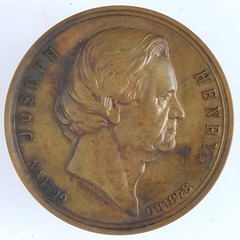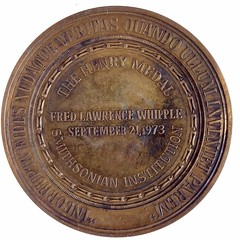
PREV ARTICLE
NEXT ARTICLE
FULL ISSUE
PREV FULL ISSUE
VOCABULARY TERM: INSERT DIEDick Johnson submitted this entry from his Encyclopedia of Coin and Medal Terminology. Thanks. -Editor
  The entire center panel on the reverse of this medal is an insert, separately engraved, to be inserted in a die with the center hollowed out to receive the insert. The specially prepared hollowed out die -- the insert die – with the insert in place produces raised lettering when struck. This method of medal making is used where a number of raised relief lettering is needed using the same obverse die. The raised edge of the insert is most obvious at the lower right just inside the chain border on the reverse of this medal. Insert Die. A special die and its supplemental part – an insert – employed to produce raised lettering on a medal. The die to contain the insert is machined with a cavity by a tool and die maker. The cavity has bevel sides. The insert blank is made of steel, also by a tool and die maker; it is shaped to fit the cavity in the insert die The insert blank is engraved incuse by a hand or machine engraving to contain the desired lettering. During striking the insert lies loose in the base die – only one side of a medal may have an insert and this die must be in the lower position in the press (it would fall out of the die in the upper position). Raised lettering is produced by this method, but always a tiny raised ridge outlining the insert appears as FLASH on a piece so struck; this line is diagnostic of the use of an insert. It may be removed by chasing on the struck piece if considered too obvious and unwanted. A small or large quantity of medals with raised lettering can be made efficiently by the use of inserts from one SETUP of the press. Each insert must be engraved separately with the recipient’s name and placed by hand in the insert die before striking. The award medals of the Columbian Exposition, for example, were struck by insert dies. (See adjacent box.) The first use of insert dies in America occurred during the Civil War. Numismatist Q. David Bowers found this technology was employed by Boston diesinker Joseph Merriam in 1863. From 1870s to 1920s billiard supply manufacturers provided tokens to their clients with their name (and sometimes the denomination) struck by insert die on the reverse. The tokens bore the advertisement of the billiard company on the obverse. Over two dozen such firms made tokens for use by billiard parlors, the tokens often bore an illustration of a pool table. Any piece struck by an insert die without its insert would contain a large shapeless raised lump resulting from the cavity. On the opposite side would be a depression or GHOSTING effect as metal
in the blank is drawn toward the cavity. See DIES AND DIEMAKING.
Looking for the meaning of a numismatic word, or the description of a term? Try the Newman Numismatic Portal's Numismatic Dictionary at: https://nnp.wustl.edu/library/dictionary Wayne Homren, Editor The Numismatic Bibliomania Society is a non-profit organization promoting numismatic literature. See our web site at coinbooks.org. To submit items for publication in The E-Sylum, write to the Editor at this address: whomren@gmail.com To subscribe go to: https://my.binhost.com/lists/listinfo/esylum All Rights Reserved. NBS Home Page Contact the NBS webmaster 
|